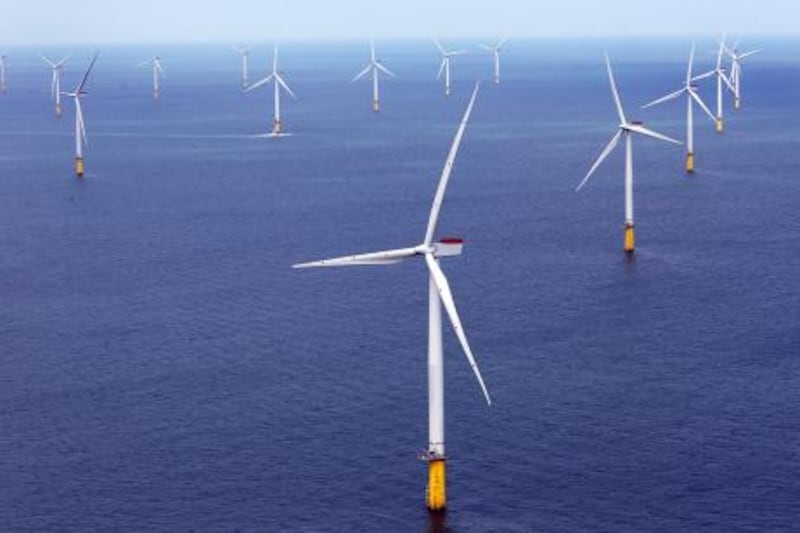[ Masdar ]
is seeking its next UK
[ clean energy ]
project after the world's largest offshore wind farm was inaugurated in the Thames estuary yesterday.
The London Array, an assembly of 175 turbines that rise out of the waters of the Thames estuary that can produce up to 630 megawatts of electricity, owes its existence in no small part to Abu Dhabi.
Masdar, the emirate's clean energy company, agreed to take a 20 per cent stake in the project in 2008, after Shell pulled out of the consortium with the Danish wind-farm developer Dong and the German power company E.ON.
The £2.2 billion (Dh12.17bn) wind farm is Masdar's largest renewable energy venture to date, and has given the company an appetite for more investments of its kind.
"We are exploring further investment opportunities," said Sultan Al Jaber, the chief executive, who said that the British government has created a favourable investment climate. "It does cater for what is needed to advance the sector. I believe the UK regulatory framework is robust and consistent."
The second phase of the array, which will bring its capacity close to 1,000MW, is widely expected to go ahead. The company had already laid the groundwork for further investment in the UK in May, signing an initial agreement with the UK Green Investment Bank to jointly develop clean energy in the country.
That coincided with a state visit to the UK by Sheikh Khalifa, President of the UAE, during which a number of behind the scenes discussions over closer business ties took place.
"The United Arab Emirates has a strong legacy in the energy sector," said Sheikh Abdullah bin Zayed, UAE Minister of Foreign Affairs. "We believe that by addressing energy security balancing the sources of power we rely on we can also create economic and social opportunity. Through Masdar, the UAE is seriously addressing this goal."
Britain's coalition government under the prime minister David Cameron has made great efforts to increase business with the Arabian Gulf, and the British leader came to Abu Dhabi last November to promote interests such as oil concessions in the emirate to the sale of fighter jets.
At yesterday's launch, the prime minister spoke of the success in attracting foreign investment.
"Last year, foreign direct investment into Europe as a whole went down by something like 40 per cent, but in the UK it went up by 24 per cent. We are making this country incredibly attractive for investors," Mr Cameron said.
The powerful elegance of the London Array's 147 metre-tall turbines is a testament to British commitment to renewable energy.
From a distance, a turbine's seemingly gradual rotation fails to convey the energy of its movements. Up close, the swooshing sound made by the blades as they cut through the air gives a better indication of the sheer power of wind, and the potential to harness it.
More than most countries, the UK is intent on utilising the wind's energy. The London Array is part of the second phase of wind farm development, one that will boost offshore wind power capacity to 8 gigawatts.
By the middle of this decade, a third phase of development is scheduled to begin, with wind farms that are set to dwarf the London Array in size.
Already, a small array near Grimsby is piloting a new 6MW Siemens wind turbine - the London Array's turbines each generate up to 3.6MW - and a new generation of these structures will make up windfarms that could push offshore capacity towards the potential 33GW-level targeted in 2009 in the UK Offshore Energy Strategic Environmental Assessment.
The stumbling block could be recent enthusiasm about shale gas reserves in the country. Last month, a study by the British Geological Survey found that the UK probably holds 1.3 trillion standard cubic feet of gas trapped in shale rock formations, double the previous estimates.
In the US, the extraction of shale gas through hydraulic fracturing, or fracking, techniques has dramatically increased the supply of gas. Even before the findings, the UK finance minister George Osborne and other senior figures in the ruling coalition have endorsed a "dash for gas" - exploiting the country's shale resources at the expense of the renewables sector.
But the use of natural gas in power generation complements rather than undermines the development of the renewables sector, said Greg Barker, UK minister of state for energy and climate change.
"Rather than a new generation of domestically produced shale gas being a threat to the renewables agenda, I actually see it as a vital partner for a large scale roll out of renewables in the UK," he said.





